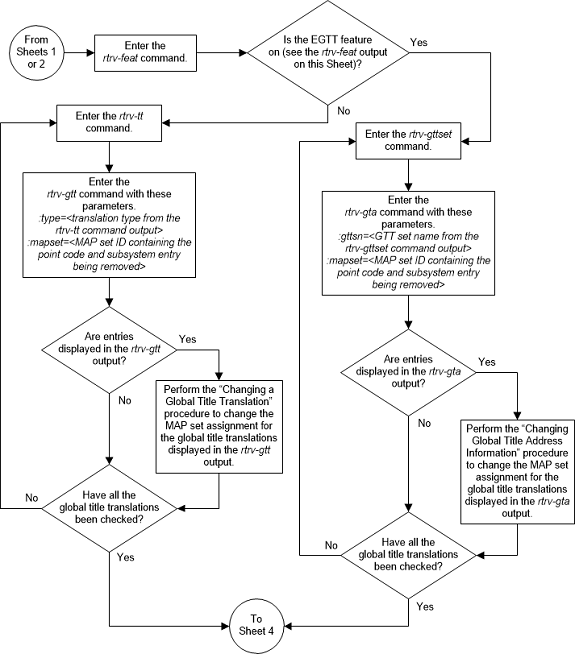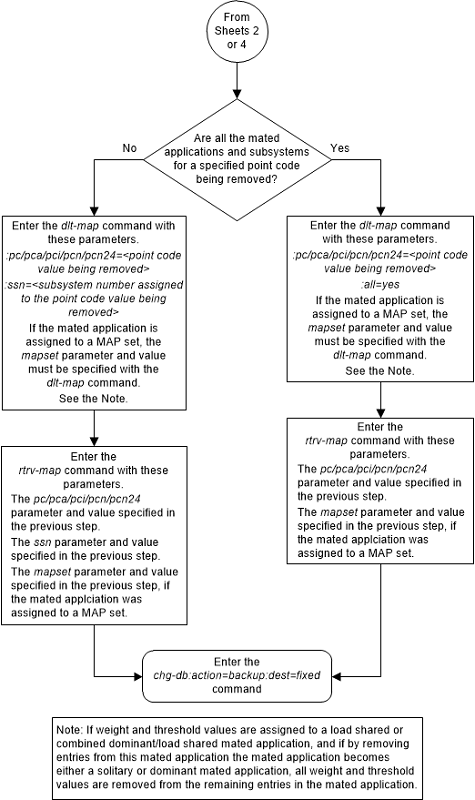| Oracle® Communications EAGLE Database Administration - GTT User's Guide Release 46.7 E97332-02 |
|
 Previous |
 Next |
| Oracle® Communications EAGLE Database Administration - GTT User's Guide Release 46.7 E97332-02 |
|
 Previous |
 Next |
This procedure is used to remove a mated application from
the database using the
dlt-map command.
The
dlt-map command uses these parameters.
:pc/pca/pci/pcn/pcn24 –
The point code (primary or mate point code) in the mated application group.
Note:
Refer to Chapter 2, Configuring Destination Tables, in Database Administration - SS7 User's Guide for a definition of the point code types that are used on the EAGLE and for a definition of the different formats that can be used for ITU national point codes.:ssn – Subsystem number –
the subsystem number of the point code being removed.
:all – Removes all
subsystems assigned to the point code being removed. If this parameter is not
specified, only the specified subsystem number is removed.
:mapset – The MAP set ID
that the mated application is assigned to, shown in the
rtrv-map output. MAP set IDs are shown
only if the Flexible GTT Load Sharing feature is enabled. If the Flexible GTT
Load Sharing feature is enabled, the
mapset parameter must be specified with
the
dlt-map command.
:mrnset - The MRN set
ID assigned to the MAP set. This is the MRN set from which alternate routing
indicator searches are performed. The mrnset parameter is shown in the
rtrv-map output only if the GTT Load
Sharing with Alternate Routing Indicator feature is enabled.
If an entire MAP set is being removed in this procedure
(with the
all=yes parameter), the reference to
the MAP set specified in this procedure must be removed from any GTT, GTA, GSM
OPCODE, GSM MAP screening, or MRN entries before an entire MAP set can be
removed.
Perform one of these procedures to remove the reference to the MAP set.
rtrv-gtt command to verify the MAP
set ID references in the GTT entries. Perform
Changing a Global Title Translation
to remove the references to the MAP set.
rtrv-gta command to verify the MAP
set ID references in the GTA entries. Perform
Changing Global Title Address Information
to remove the references to the MAP set.
rtrv-gsms-opcode command to verify
the MAP set ID references in the GSMOPCODE entries. Perform the “Changing a
GSMMAP Screening Operation Code” procedure in
Database Administration - Features User's
Guide to remove the references to the MAP set.
rtrv-gsmmap-scrn command to verify
the MAP set ID references in the GSMMAP screening entries. Perform the
“Changing a GSM MAP Screening Entry” procedure in
Database Administration - Features User's
Guide to remove the references to the MAP set.
rtrv-ppsopts command to verify that
the mated application's point code (if the Flexible GTT Load Sharing feature is
not enabled) or the point code and MAP set ID (if the Flexible GTT Load Sharing
feature is enabled) is not shown in the
rtrv-ppsopts output. Any references
to the mated application's point code or the point code and MAP set ID in the
rtrv-ppsopts output are removed in
15.
rtrv-mrn command.
The last entry of a MAP set, other than the default MAP
set, whose MAP set ID is referenced by a GTA entry in the GTT table cannot be
removed if the
xlat and
ri parameter values for that GTA entry
are
dpcssn and
ssn. Perform
Changing Global Title Address Information
to remove the references to the MAP set.
Note:
If weight and threshold values are assigned to a load shared or combined dominant/load shared mated application, and if by removing entries from this mated application the mated application becomes either a solitary or dominant mated application, all weight and threshold values are removed from the remaining entries in the mated application.If the
mapset=dflt and
all=yes parameters are specified with
the
dlt-map command, only the MAP group
containing the point code value specified in the
dlt-map command is removed from the
default MAP set.
The mated application must be in the database.
Either the
ssn or
all parameters can be specified with
the
dlt-map command, but not both.
If the
ssn parameter is specified, the point
code and subsystem pair must exist in the mate application entity set. The
point code and subsystem entry is then removed.
The value of the
ssn parameter must be from 2 to 255.
Removing all point codes but one from a dominant, load shared, or combined dominant/load shared mated application group creates a solitary mated application.
If the primary point code is removed from a dominant mated application group containing more than one mate point code, the mate point code with the lowest relative cost value becomes the new primary point code.
If the primary point code is removed from a load shared mated application group containing more than one mate point code, the next mate point code in the group becomes the new primary point code.
If the primary point code is removed from a combined dominant/load shared mated application group containing more than one mate point code, which mate point code, and the resulting mated application group depends on the resulting relative cost values remaining in the group.
Mated applications that contain the EAGLE's true point
code and the subsystem number of one of the subsystems shown in
Table 2-51
cannot be removed from the database unless the subsystem has been removed from
the database. The EAGLE's true point code is shown in the
PCA,
PCI,
PCN, or
PCN24 fields of the
rtrv-sid output. The subsystem number
is shown in the
SSN field of the
rtrv-ss-appl output.
Table 2-51 Subsystem Features
| Feature | Subsystem | Feature Status | User's Guide that Contains the Procedures to Remove the Subsystem |
|---|---|---|---|
| LNP | LNP | Enabled | ELAP Administration and LNP Feature Activation |
| INP | INP | Enabled and Turned On | INP/AINPQ |
| ANSI-41 INP Query | |||
| EIR | EIR | Enabled and Turned On | EIR |
| V-Flex | V-Flex | Enabled and Turned On | V-Flex |
| ATINP | ATINPQ | Enabled | ATINP |
| ANSI41 AIQ | AIQ | Enabled | Analyzed Information Features |
Canceling the
RTRV-MAP Command
Because the
rtrv-map command used in this procedure
can output information for a long period of time, the
rtrv-map command can be canceled and
the output to the terminal stopped. There are three ways that the
rtrv-map command can be canceled.
F9 function key on the keyboard at
the terminal where the
rtrv-map command was entered.
canc-cmd without the
trm parameter at the terminal where
the
rtrv-map command was entered.
canc-cmd:trm=<xx>, where
<xx> is the terminal where the
rtrv-map command was entered, from
another terminal other that the terminal where the
rtrv-map command was entered. To
enter the
canc-cmd:trm=<xx> command, the
terminal must allow Security Administration commands to be entered from it and
the user must be allowed to enter Security Administration commands. The
terminal’s permissions can be verified with the
rtrv-secu-trm command. The user’s
permissions can be verified with the
rtrv-user or
rtrv-secu-user commands.
For more information about the
canc-cmd command, refer to
Commands User's Guide.
Figure 2-101 Remove a Mated Application - Sheet 1 of 5

Figure 2-102 Remove a Mated Application - Sheet 2 of 5

Figure 2-103 Remove a Mated Application - Sheet 3 of 5

Figure 2-104 Remove a Mated Application - Sheet 4 of 5

Figure 2-105 Remove a Mated Application - Sheet 5 of 5
